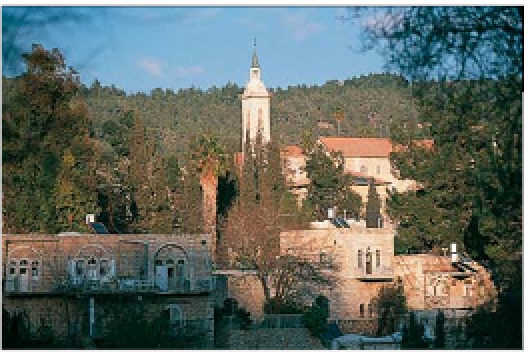Travel Reference
In-Depth Information
Baptist was born and lived
here. The village boasts
several fine churches and
monasteries connected with
his life. Recognizable by its
tall, thin tower, the Franciscan
Church of St John the Baptist
dates from the 17th century,
but is built over the ruins
of earlier Byzantine and
Crusader structures. Steps
inside the church lead down
into a natural cave, known as
the Grotto of the Nativity of
St John, which tradition
connects with the birth of
the Baptist.
The other church of note is
the two-tiered
Church of the
Visitation
, completed in
1955 to a design by Antonio
Barluzzi, architect of the
Dominus Flevit Chapel
(see
p113)
and the Chapel of the
Flagellation
(see p64)
. It
commemorates the Virgin
Mary's visit to Elizabeth,
mother of John the Baptist,
who was then pregnant,
an episode depicted in
mosaic on the church's
façade. Within is a natural
grotto, in front of which are
the remains of Roman-era
houses. According to tradition,
the grotto is where Elizabeth
hid with her infant son to
escape from the Massacre of
the Innocents (the killing of
all first-born sons, ordered by
King Herod). The courtyard
walls are lined with tiled
panels inscribed with the
Magnificat t
Luke 1: 46-55),
Mary's hymn of thanks, in
42 languages.
At the bottom of the hill
below the church is a small,
abandoned mosque. Beside it
surfaces the spring (popularly
known as the Spring of the
Virgin) from which the village
takes its name.
One of the other pleasures
to savour in Ein Kerem is its
tranquil, wooded, valley
setting. This can be best
appreciated on a beautiful
scenic walk
that starts
beside the
sculpture at
the beginning
of the access
road to Yad
Y
Vashem, and
winds through
the trees.
Church of St John the Baptist, Ein Kerem
Hadassah Hospital
Synagogue
w
Ein Kerem.
Tel
(02) 677 6271.
and had to be repaired by the
artist. However, one of the
windows (a green one) bears
a small symbolic bullet hole
in the lower half, deliberately
left there as a testimony to
the fighting.
l
@
19, 27.
#
8am-1pm &
2-3:30pm Sun-Thu, 8am-
12:30pm Fri.
& 8 ^
Abu Ghosh
e
13 km (8 miles) W of central
Jerusalem.
@
185, 186.
A splendid cycle of 12 stained-
A
glass windows decorates
the synagogue at the other-
wise unremarkable Hadassah
Hospital. The windows were
created in 1960-61 by the
Russian-- ewish artist Marc
Chagall
(see p33)
, and installed
the following year for the
inauguration of the building.
Each of the windows repre-
sents one of the 12 tribes of
Israel (Genesis 49). Tradition
associates each of the tribes
with a symbol, a precious
stone and a social role, and
these elements are all repre-
sented in Chagall's imagery
and choice of colour.
Several of the windows
were damaged by shrapnel
during the 1967 War
(see p54)
This Arab village just nort
h
of
the main Jerusalem-Tel Aviv
A
highway was considered by
the Crusaders to be Emmaus,
where Christ appeared to two
disciples in the days after his
Resurrection. The beautiful
Romanesque
Crusader Church
was built in the early 12th
century by the Knights
Hospitallers and stands almost
complete in its original form.
Its 12th-century frescoes are
lovely, but in a poor state of
repair. The adjacent early 20th-
century monastery belongs to
French Olivetan Benedictine
monks, who produce pottery.
Up on the hill above the village
stands the
Church of Notre
Dame de l'Arche de l'Alliance
,
built in 1924 over the remains
of a 5th-century church, whose
mosaics are still visible. It is
said to occupy the site of the
house of Abinadab, where
the fabled
Ark of the
Covenant
(see p21)
rested for
20 years
(1 Samuel 7:
1-2) until
David took it
to Jerusalem.
The modern Church of Notre Dame de l'Arche de l'Alliance, Abu Ghosh













